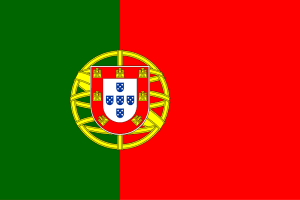
| Colors | HEX Code | RGB | CMYK |
|---|---|---|---|
| Green | #006600 | 0, 102, 0 | 100, 0, 100, 60 |
| Red | #FF0000 | 255, 0, 0 | 0, 100, 100, 0 |
| Gold | #FFFF00 | 255, 255, 0 | 0, 0, 100, 0 |
| White | #FFFFFF | 255, 255, 255 | 0, 0, 0, 0 |
| Blue | #03369A | 3, 54, 154 | 98, 65, 0, 40 |
| Black | #373600 | 55, 54, 0 | 0, 2, 100, 78 |
The Flag of Portugal is a bicolor with two unequal stripes. The stripe at the hoist is green, while the other stripe is red stretching towards the fly side. The coat of arms is located on the line between the two colors. The coat of arms features a red shield bordered with white, including a smaller white shield that includes five blue and white mini-shields arranged in a cross pattern. There are also seven golden castles on the red background of the shield, there is a golden armillary sphere. On the sides of the sphere are two laurel branches bound together in base by a ribbon.
Meaning of the Flag of Portugal
The green color represents the hope of achievement. The red color symbolizes the blood that is shed during the nation’s battles and the courage of the Portuguese people. The five small shields represent the five Moorish kings that Afonso I, Portugal’s first king, defeated. The seven golden castles represent the historical Moorish fortresses conquered. The armillary sphere represents Portugal’s maritime history and exploration. The two branches with the ribbon represent peace.
History of the Flag of Portugal
The first recorded flag in Portugal had a white background with a dark blue cross. Later, the white flag with several versions of coats of arms were adopted by the kings of Portugal. In 1816, the armillary sphere was added to the coat of arms to represent voyages of exploration. In 1910, the monarchy was overthrown. In 1911, the armillary sphere was revived behind the coat of arms. The red and green colors were chosen because they were not related to Monarchy. A new coat of arms was chosen to be added to the flag.